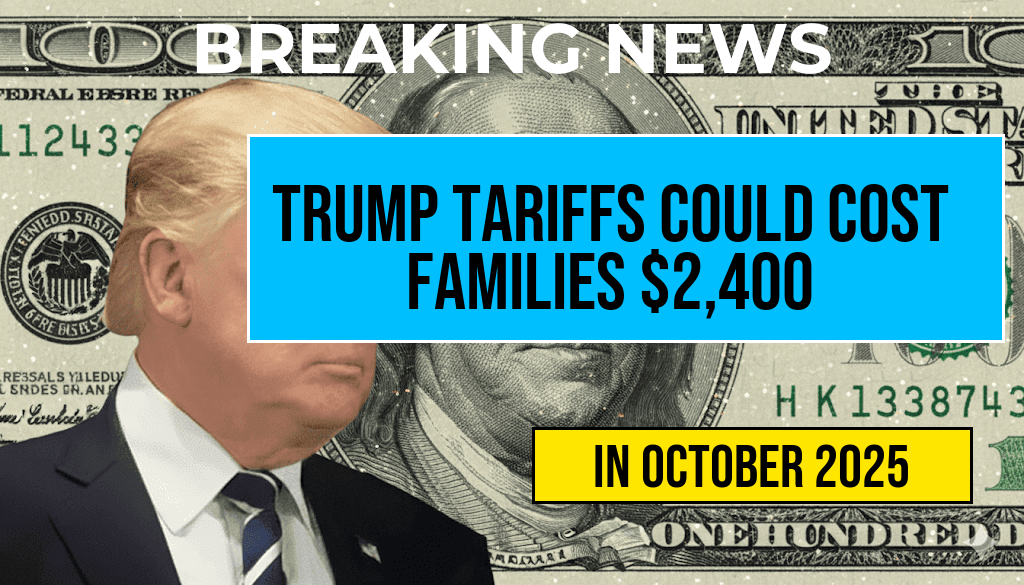Recent analyses suggest that the continuation or expansion of Trump-era tariffs could elevate average American household expenses by approximately $2,400 annually. Often referred to as the “Turbulence Tax,” these tariffs—imposed primarily on imported goods from China and other trading partners—are now being scrutinized for their broader economic impact on consumers. While initially intended to protect domestic industries, critics argue that the ripple effect has shifted significant costs onto families, affecting everything from groceries to electronics. As policymakers debate the future of these tariffs, understanding their real-world implications becomes essential for consumers and economic strategists alike.
The Mechanics Behind the “Turbulence Tax”
The so-called “Turbulence Tax” describes the indirect costs borne by consumers resulting from tariffs aimed at foreign imports. When tariffs increase the price of imported goods, businesses often pass these costs onto consumers through higher retail prices. This phenomenon can be particularly impactful in sectors reliant on global supply chains, including electronics, apparel, and household items.
How Tariffs Influence Consumer Prices
- Cost Pass-Through: Importers and retailers often transfer tariff costs directly to buyers, especially when domestic alternatives are limited.
- Supply Chain Disruptions: Tariffs can cause delays and shortages, leading to increased manufacturing costs and higher retail prices.
- Market Uncertainty: Tariffs create volatility, prompting companies to raise prices preemptively to hedge against future costs.
Quantifying the Impact on American Families
Economists have attempted to estimate the cumulative financial burden of these tariffs on households. A recent study indicates that, on average, American families could face an increase of about $200 to $250 per month in expenses attributable to tariff-related price hikes. Over the course of a year, this accumulates to roughly $2,400, representing a significant addition to household budgets.
Breakdown of Affected Expense Categories
| Category | Additional Cost (per year) |
|---|---|
| Electronics & Appliances | $800 |
| Clothing & Footwear | $600 |
| Food & Beverages | $500 |
| Home Goods & Furniture | $300 |
These figures reflect the combined effect of tariffs on imported goods and the subsequent price adjustments across retail channels. The impact is particularly pronounced for lower- and middle-income households, where a larger proportion of their budget is allocated to essential goods affected by tariffs.
Economic and Political Considerations
The debate over tariffs extends beyond immediate consumer costs. Proponents argue that tariffs serve as leverage to renegotiate trade agreements, aiming to restore fairer terms and protect domestic manufacturing jobs. However, critics highlight that the increased living expenses—especially during periods of economic uncertainty—may undermine consumer confidence and overall economic growth.
Potential Policy Responses
- Tariff Rollbacks: Reducing or removing tariffs could mitigate the “Turbulence Tax,” lowering prices for consumers.
- Trade Diversification: Encouraging domestic production and diversifying supply chains can lessen dependency on imports vulnerable to tariffs.
- Targeted Compensation: Implementing social programs or subsidies to offset increased costs for vulnerable populations.
Broader Implications and Outlook
As negotiations continue and trade policies evolve, the real-world impact on American families remains a critical focal point. The “Turbulence Tax” exemplifies how international trade tensions can reverberate through household budgets, often in ways not immediately apparent to consumers. Policymakers face the challenge of balancing strategic trade objectives with economic realities, especially as inflationary pressures persist.
For more insights into the historical context of tariffs and their economic effects, visit Wikipedia’s page on tariffs. Economic forecasts and consumer impact studies can be found through sources like Forbes.
Frequently Asked Questions
What are the main concerns regarding the impact of Trump tariffs on family expenses?
The primary concern is that the Trump tariffs could increase family expenses by approximately $2,400 annually, affecting household budgets and economic stability for many families.
How do tariffs contribute to the so-called ‘Turbulence Tax’?
The ‘Turbulence Tax’ refers to the additional costs imposed on consumers due to tariffs, which create economic instability and lead to higher prices for goods, ultimately increasing family expenses.
Which sectors are most affected by these tariffs and how does this impact families?
Key sectors such as retail, manufacturing, and agriculture are most affected by tariffs, resulting in higher prices for everyday products and increased cost of living for families.
Are there specific products that families should be aware of that may become more expensive?
Yes, families may notice increased costs on consumer electronics, clothing, food items, and other imported goods due to tariffs, raising overall household expenses.
What can families do to mitigate the financial impact of these tariffs?
Families can consider budget adjustments, seek alternative domestic products, and stay informed about policy changes to better manage potential increases in expenses.

Leave a Reply